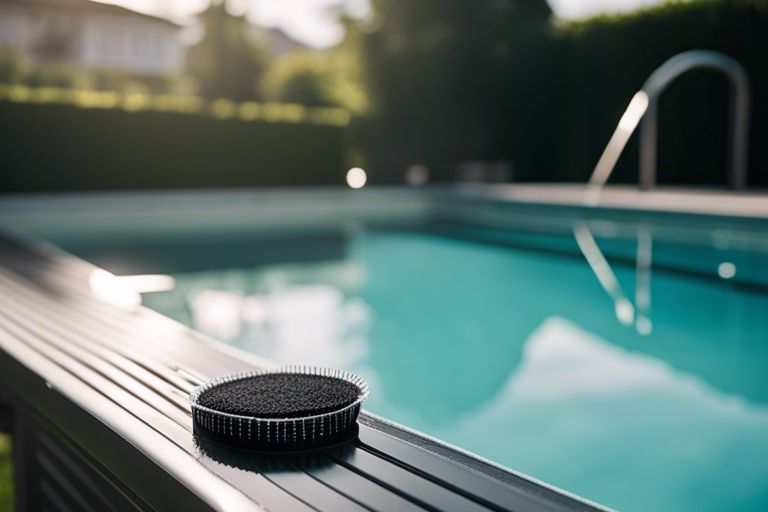Perplexed by the appearance of black algae in your pool? You’re not the only one. I’ve encountered this issue before, and it can be a real headache to deal with. Black algae can be dangerous to swimmers and may be a sign of inadequate pool maintenance. In my latest blog post, I’ll share with you the most effective treatment and prevention tips to rid your pool of black algae and keep it from coming back. If you’re still having trouble, I recommend checking out this helpful thread on the Pool Help Forum, where users discuss the option of draining the pool to get rid of black algae: Drained pool to rid of Black Algae question. Let’s get that pool back to sparkling clean!
Key Takeaways:
- Proper maintenance of chlorine levels and regular brushing of pool walls can help prevent black algae growth.
- Use a specialized algaecide designed specifically for black algae to effectively eradicate the problem.
- Thoroughly scrub affected areas with a stiff brush to ensure the algaecide penetrates and eliminates black algae from the pool surfaces.
- Regularly shock the pool to prevent and treat black algae issues.
- Proactively address any signs of black algae growth to prevent it from spreading and becoming more difficult to eliminate.
Understanding Black Algae
Before I delve into the treatment and prevention of black algae in pools, it’s important to understand this pesky and persistent problem.
Characteristics and Identification
Black algae, scientifically known as Nostoc, is a type of cyanobacteria that can form stubborn, dark-colored spots or patches on the walls and floors of swimming pools. Unlike green or mustard algae, black algae have a hardened, protective outer layer that makes it resistant to normal chlorine levels and brushing. They can even grow and thrive in the cracks and crevices of pool surfaces, making them extremely difficult to remove.
Causes of Black Algae in Pools
So, why does black algae appear in pools? The primary cause of black algae infestation is poor pool maintenance. This includes inadequate sanitization, irregular brushing, and imbalanced water chemistry. Additionally, black algae spores can also be introduced into the pool through contaminated pool equipment, bathing suits, or even the wind.
In my experience, the presence of black algae in a pool can be a serious problem. Its stubborn nature and ability to survive in harsh conditions makes it a significant challenge for pool owners and maintenance professionals. It is crucial to identify and understand the characteristics and causes of black algae in order to effectively treat and prevent its recurrence. Understanding these aspects will empower you to take the necessary steps to maintain a clean and safe swimming environment for yourself and your loved ones.
Treatment of Black Algae
Obviously, the presence of black algae in your pool is a cause for concern. It’s important to start treatment as soon as you notice any signs of black algae to prevent it from spreading and becoming more difficult to remove. In this chapter, I will discuss the various treatment options available to effectively get rid of black algae in your pool.
Step-by-Step Removal Process
When it comes to removing black algae from your pool, it’s crucial to follow a systematic approach to ensure thorough treatment. Below is a step-by-step removal process that I recommend:
| Step 1 | Brush the affected areas vigorously to break down the algae’s protective layer. |
| Step 2 | Shock the pool with an algaecide to kill any remaining algae spores. |
| Step 3 | Use a metal pool brush to scrub the affected areas again to remove any remaining dead algae. |
| Step 4 | Thoroughly vacuum the pool to remove the debris. |
Effective Chemical Treatments
Chemical treatments are often the most effective way to eradicate black algae from your pool. I recommend usingchlorine-based shock treatments to kill the algae and prevent its regrowth. A copper-based algaecide can also be effective in treating stubborn black algae outbreaks.
Non-Chemical Treatment Options
If you prefer to avoid using harsh chemicals in your pool, there are non-chemical treatment options available. One effective method is toincrease the pool’s water temperature to around 86°F (30°C) and then vigorously brush the affected areas. This can help weaken the algae and make it easier to remove. Another option is to useenzyme-based cleaners to break down the algae without the need for harsh chemicals.

Prevention Tips
Despite being a tough nuisance to tackle, fighting black algae in your pool is not an impossible task. By following these prevention tips, you can significantly reduce the risk of black algae infestation in your pool:
- Consistent Chlorine Levels: Maintain proper chlorine levels in your pool to prevent the growth of black algae.
- Regular Brushing: Brush the pool walls and floor weekly to prevent algae from taking hold.
- Shock Treatments: Perform regular shock treatments to kill off any potential algae spores.
- Proper Water Circulation: Ensure that your pool has good water circulation to prevent stagnant areas where algae can thrive.
Assume that any neglect in these prevention measures will increase the risk of black algae growth in your pool.
Regular Pool Maintenance
Regular pool maintenance is crucial for preventing the growth of black algae. By keeping the pool clean and well-balanced, you can reduce the risk of infestation. This includes regularly testing and adjusting the pool’s chemical levels, skimming debris off the surface, and vacuuming the pool floor to remove any potential algae spores.
Algae-Resistant Pool Surfaces
Investing in algae-resistant pool surfaces can significantly reduce the risk of black algae growth. Smooth and non-porous pool surfaces are less likely to harbor algae, making it easier to brush and maintain a clean pool environment.
Proper Water Filtration and Circulation
Proper water filtration and circulation are essential for preventing black algae growth. A high-quality filtration system will help remove algae spores and other debris from the water, while good circulation will prevent stagnant areas where algae can take hold. Regularly cleaning and maintaining your filtration system is key to preventing black algae in your pool.

Black Algae in a Pool – Treatment and Prevention Tips
Presently, I have provided you with effective treatment and prevention tips for dealing with black algae in your pool. By following these strategies, you can ensure that your pool remains clean, safe, and enjoyable for everyone. Remember to regularly brush the pool walls and floor to prevent algae buildup, maintain proper chlorine and pH levels, and use algaecide when needed. Additionally, taking proactive measures such as using a quality pool cover and keeping the area around the pool clean can significantly reduce the risk of black algae infestations. By staying informed and consistently implementing these practices, you can keep the black algae at bay and enjoy your pool to the fullest.
FAQ
Q: What is Black Algae in a Pool?
A: Black algae is a type of stubborn and hardy algae that can form in swimming pools. It appears as dark black or blue-green spots on the pool walls and floors.
Q: How can I treat Black Algae in my Pool?
A: Treating black algae requires a combination of physical scrubbing and the use of algaecide specifically designed for black algae. The affected areas must be scrubbed with a stiff brush to break open the protective layer and allow the algaecide to penetrate.
Q: What are some prevention tips for Black Algae in a Pool?
A: To prevent black algae from forming in your pool, it is important to maintain proper water chemistry, including regular shock treatments and chlorine levels. Regularly brushing the pool walls and floors can also help prevent the growth of black algae.
Q: Can Black Algae be harmful to swimmers?
A: While black algae itself is not harmful, it can create a rough and unsightly surface in the pool. If left untreated, it can also provide a hiding place for harmful bacteria and other pathogens.
Q: How long does it take to get rid of Black Algae in a Pool?
A: The process of eliminating black algae from a pool can take several days to a few weeks, depending on the severity of the infestation and the effectiveness of the treatment. Consistent and thorough treatment is important for complete eradication.









Leave a comment